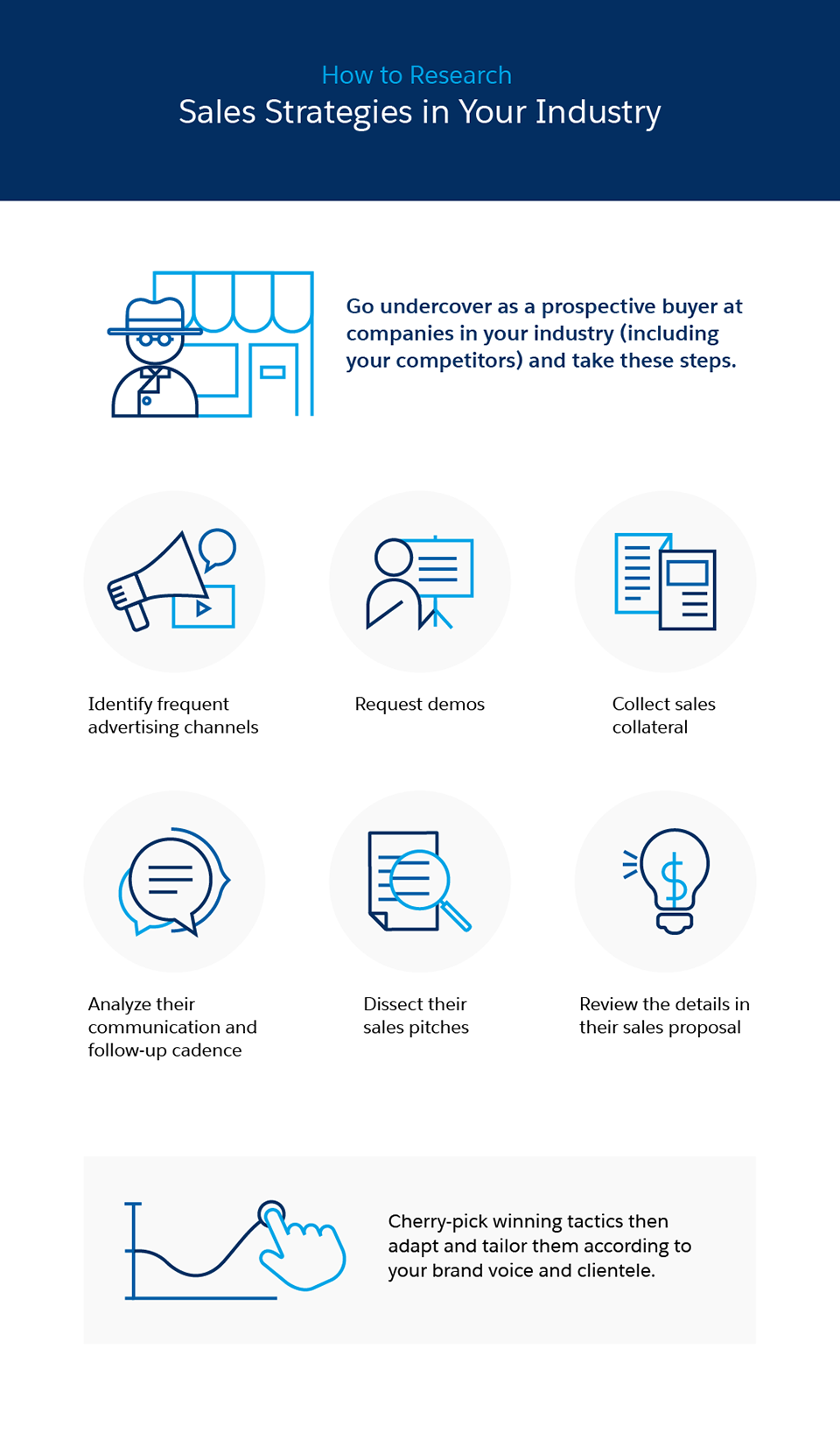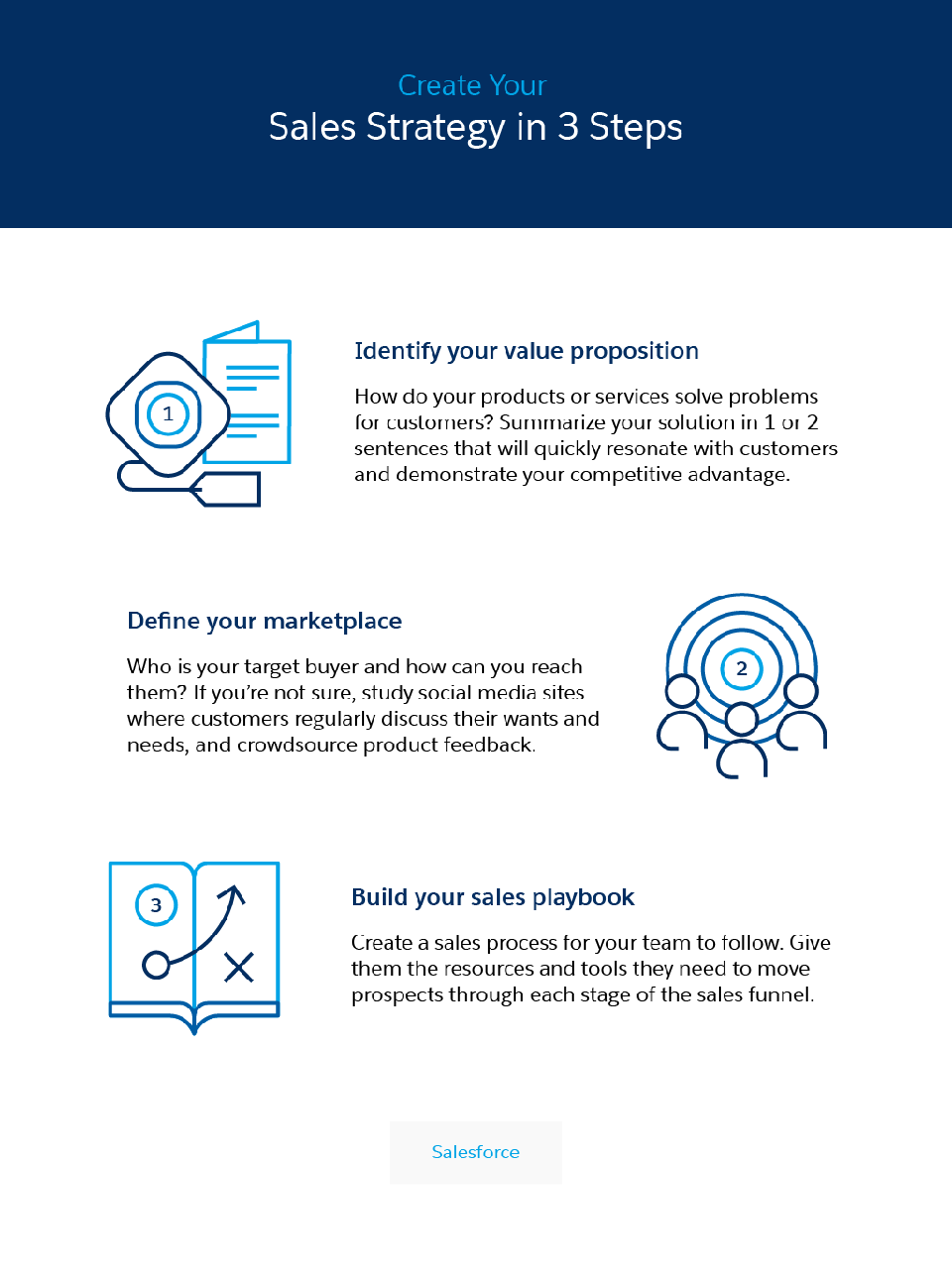In today’s ultra-competitive business arena, having quality products and services is essential, but it will only get you so far. Long-term growth and success depend on your company’s ability to create, implement, and execute successful sales strategies.
A sales strategy is a detailed and methodical plan to allocate resources to close more sales. Top sales strategies don’t happen overnight. Most are the result of thoughtful planning, a significant amount of trial and error, and consistent refinement and optimization. In this article, we’ll help you create clear and concrete sales strategies for your small business.
Divide the Sales Strategy Process Into Steps
You can break a sales strategy into three stages.
1. Create: Develop a plan to get in front of new prospects and guide them through the full sales funnel.
2. Implement and Execute: Start and follow through with each step to initiate conversations, engage prospects, educate them, and win over their business.
3. Refine: Analyze your approach, audit your results, and make tweaks to improve your sales conversion rates and contract sizes.
Effective sales planning doesn’t come naturally to most businesses. Many product-focused organizations generate a large portion of their sales from inbound inquiries and referrals. Word-of-mouth sales demonstrate a brand’s appeal and the value of its products to customers. However, a strong dependence on inbound inquiries and referrals can lead companies to run sporadic marketing or outreach campaigns. Moreover, in some cases, a company’s sales strategy may solely focus on inbound leads.
A 2019 study from Outbound Engine found “50 per cent of [small and medium business (SMB) owners throughout the U.S] do not have a marketing plan.” Without a marketing plan, businesses usually find themselves unable to develop a sales strategy because marketing and sales go hand-in-hand.
Explore Sales Strategy Examples Within Your Industry (and Among Rivals)
To implement sales strategies that work, business owners and sales leaders need to first acquaint themselves with the types of sales strategies common to their industry. By doing so, you can find the best sales strategy examples to emulate. You should study your competitors to discover their proven sales strategies for new prospects.

Examples of Sales Strategies
Of course, different types of sales strategies work for different aspects of a business. The most common examples of sales strategies include these categories.
Inbound
Outbound
Retail
Inside
Sales promotion
Online
Direct
It’s difficult to prioritize just one sales strategy example. Each is complex, and they vary depending on the intent, industry, and scope.
Understand the Impact of a Sales Strategic Plan
The foundation of any successful sales strategic plan considers the most effective way to allocate resources to close more sales.
Many entrepreneurs believe better marketing is the key to growing sales. Indeed, marketing is an important part of building your brand, but it’s only the starting point. Marketing helps generate sales leads while your sales department nurtures prospects and converts them into paying customers. By running targeted marketing campaigns in tandem with a structured sales strategic plan, companies capitalize on the brand awareness marketing generates with a disciplined approach to engaging leads and closing sales.
Create Your Initial Small Business Sales Strategy
You need to tailor your sales strategies to your business. Your research may inspire you if you discover your competitors taking creative and unique sales approaches, but you’ll find the most success by cherry-picking winning tactics and adapting them to your brand voice and clientele.
To get started, follow these three steps.
1. Identify your value proposition.
Effective sales strategies centre on one main objective: meeting specific customer needs. Consider how your products or services solve problems for customers. Then, summarize your solution in one or two sentences that will quickly resonate with audiences and demonstrate your competitive advantage. When you start with a compelling value proposition, customers’ ears perk up. It’s generally easier to offer someone a solution to a problem they already face than to pitch a product or service they may not understand or need.
2. Define your marketplace.
Determine who your target buyer is and how to reach them. You don’t want your team to invest time and energy in pitching the wrong types of customers. Many sales teams use social media to define their marketplace. Potential customers discuss their wants and needs, and crowdsource product feedback on social sites such as Facebook before making a purchase decision. Use this data to gain critical insights to help you formulate better offline and online sales strategies. By defining your target audience, you can prioritize the right outreach efforts and leads, and ensure you put your best resources to work on your most promising opportunities.
3. Outline your game plan.
Build your unique sales playbook after you consider all your research. Create a process for your team to follow so they have the resources and tools they need to move prospects through each stage of the sales funnel. Then, distribute it internally so all your salespeople have access to it on social sites such as Facebook.

Implement & Execute Your Sales Strategies
According to a quote often attributed to inventor Thomas Edison, “Vision without execution equals hallucination.” In other words, the best sales strategies in the world will only yield results if you implement them.
Some organizations are excellent at planning but fall short when it’s time to follow through. That's partly because some teams don't have trained sales managers. A study from Vantage Point and the Sales Management Association found that "41 per cent of participating companies did not have specific sales manager training initiatives." According to the study, "The companies with [sales manager training] initiatives — 59 per cent — outperformed the others, by 16 per cent." Even with a comprehensive playbook, you’ll have a large margin for error without the right leadership.
It’s crucial to have a leader to keep your team accountable for following each step of your sales strategic plan while providing coaching, training, and regular analytics. You need to provide a clear framework for each decision throughout the sales process. From general leads to warm prospects, clearly define key decision points to guide your sales reps through the sales process efficiently.
The right level of monitoring and accountability makes it easier to:
Capture more sales opportunities
Optimize resource allocation
Improve your bottom line
Refine Your Sales Playbook and Emphasize Consistent Improvement
As your team gets into the rhythm of executing sales plans, managers should regularly review their sales force’s performance. Examine key sales metrics to quickly help leadership determine what is working and what is not.

To evaluate your team’s effectiveness, use earlier performance data or industry benchmarks to set the standard. When your sales team or a sales rep underperforms expectations, invest in further coaching and training. When your staff outperforms in some areas, revise your sales strategy to capitalize on their strengths. As you create and execute your sales strategy, you can refine each step of the process to deliver more value to prospects, save resources, and generate more sales.
Conclusion
The most successful sales teams keep themselves accountable to drive more business for their organizations, and they also consistently raise the bar for themselves. Once you implement your sales strategies, manage, monitor, tweak, and revise them to grow your business’s bottom line.


